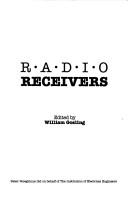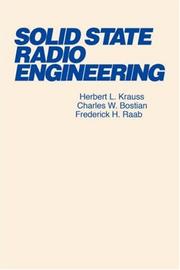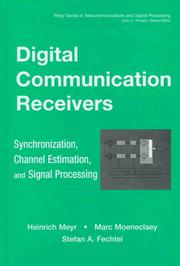| Listing 1 - 10 of 12 | << page >> |
Sort by
|
Book
ISBN: 1281026514 9786611026516 0080518591 0750673192 9780080518596 9780750673198 9781281026514 6611026517 Year: 2001 Publisher: Boston : Newnes,
Abstract | Keywords | Export | Availability | Bookmark
 Loading...
Loading...Choose an application
- Reference Manager
- EndNote
- RefWorks (Direct export to RefWorks)
The Technician's Radio Receiver Handbook is an invaluable tool for anyone involved in the technologies of wireless, cellular telephone, telecommunications, avionics, and other forms of electronic communication using radio waves. The market demand for and use of wireless and telecommunication technology has increased dramatically over the past decade, leaving many technicians and other communications professionals with the need for accurate information on how the newest equipment works and how to fix any problems that arise. Joe Carr, a notable author in the amateur radio and communications mar

ISBN: 0863410561 9780863410567 Year: 1986 Volume: 15 Publisher: London: Peregrinus,
Abstract | Keywords | Export | Availability | Bookmark
 Loading...
Loading...Choose an application
- Reference Manager
- EndNote
- RefWorks (Direct export to RefWorks)
Radio --- Receivers and reception --- -Telephone, Wireless --- Wireless (Radio) --- Wireless telephone (Early radio) --- Communication and traffic --- Telecommunication --- Telegraph, Wireless --- -Receivers and reception --- Radio receivers --- Radio-receiving apparatus --- Radio reception --- Radios --- Household electronics --- Equipment and supplies --- Radio - Receivers and reception
Periodical
ISSN: 00189308 Publisher: New York
Abstract | Keywords | Export | Availability | Bookmark
 Loading...
Loading...Choose an application
- Reference Manager
- EndNote
- RefWorks (Direct export to RefWorks)
Radio --- Television --- Télévision --- Télévision --- Receivers and reception --- Récepteurs et réception --- Engineering --- Electrical Engineering --- Radio - Periodicals. --- Television - Periodicals. --- Radio - Receivers and reception - Periodicals. --- Television - Receivers and reception - Periodicals. --- Radio - Périodiques. --- Télévision - Périodiques. --- Radio - Récepteurs et réception - Périodiques. --- Télévision - Récepteurs et réception - Périodiques.
Book
ISBN: 8847019826 9786613706430 8847019834 1280796049 Year: 2012 Publisher: Milan : Springer,
Abstract | Keywords | Export | Availability | Bookmark
 Loading...
Loading...Choose an application
- Reference Manager
- EndNote
- RefWorks (Direct export to RefWorks)
The Book contains the Vision of the researchers of the European Network of Excellence NEWCOM++ (Network of Excellence on Wireless COMmunication) on the present and future status of Wireless Communication Networks. In its content, the community of NEWCOM++ researchers, shaped under the common ground of a mainly academic network of excellence, have distilled their scientific wisdom in a number of areas characterized by the common denominator of wireless communications, by identifying the medium-long term research tendencies/problems, describing the tools to face them and providing a relatively large number of references for the interested reader. The identified areas and the researchers involved in their redaction reflect the intersection of the major topics in wireless communications with those that are deeply investigated in NEWCOM++; they are preceded by an original description of the main trends in user/society needs and the degree of fulfilment that ongoing and future wireless communications standards will more likely help achieving. The appendix of the Book contains a list of "Millenium Problems", seminal problems in the area of wireless communication networks, characterized by being crucial and still unsolved. The problems have been identified by NEWCOM++ researchers and filtered by the editors of the Vision Book.
Broadband communication systems -- Standards. --- Cell phone systems -- Standards. --- Mobile communication systems -- Standards. --- Radio -- Receivers and reception. --- Resource allocation. --- Signal processing. --- Electrical & Computer Engineering --- Engineering & Applied Sciences --- Electrical Engineering --- Telecommunications --- Wireless communication systems --- Communication systems, Wireless --- Wireless data communication systems --- Wireless information networks --- Wireless telecommunication systems --- Engineering. --- Electrical engineering. --- Communications Engineering, Networks. --- Telecommunication systems --- Telecommunication. --- Electric communication --- Mass communication --- Telecom --- Telecommunication industry --- Communication --- Information theory --- Telecommuting --- Electric engineering --- Engineering

ISBN: 047103018X 9780471030188 Year: 1980 Publisher: New York (N.Y.) : Wiley,
Abstract | Keywords | Export | Availability | Bookmark
 Loading...
Loading...Choose an application
- Reference Manager
- EndNote
- RefWorks (Direct export to RefWorks)
Radio circuits --- Circuits radio --- Receivers and reception --- Transmitters and transmission --- Récepteurs et réception --- Emetteurs et transmission --- Radiocommunication apparatus and methods (radio) --- Radio circuits. --- Receivers and reception. --- Transmitters and transmission. --- 621.396 Radiocommunication apparatus and methods (radio) --- Récepteurs et réception --- Radio --- 621.396 --- Circuits, Radio --- Electronic circuits --- Radio transmission --- Transmitting sets, Radio --- Radio broadcasting --- Radio stations --- Radio receivers --- Radio-receiving apparatus --- Radio reception --- Radios --- Household electronics --- Equipment and supplies --- Analoge elektronica --- Radio - Receivers and reception --- Radio - Transmitters and transmission
Periodical
Abstract | Keywords | Export | Availability | Bookmark
 Loading...
Loading...Choose an application
- Reference Manager
- EndNote
- RefWorks (Direct export to RefWorks)
Household electronics --- Radio --- Electronic apparatus and appliances --- Appareils électroniques domestiques --- Télévision --- Appareils électroniques --- Television --- Receivers and reception --- Récepteurs et réception --- Electronics --- Engineering. --- General and Others --- Image Processing & Television Technology. --- Telecommunications Technology. --- Engineering --- Telecommunications Technology --- Electrical Engineering --- Image Processing & Television Technology --- consumenten --- Electrical engineering --- #ANTIL9609 --- elektronica --- radioontvanger --- televisieontvangst --- Periodicals --- Composants électroniques --- Périodiques --- Elektrotechniek --- Periodicals. --- Household electronics - Periodicals --- Radio - Receivers and reception - Periodicals --- Electronic apparatus and appliances - Periodicals --- Appareils électroniques domestiques - Périodiques --- Radio - Récepteurs et réception - Périodiques --- Télévision - Récepteurs et réception - Périodiques --- Appareils électroniques - Périodiques --- Television - Receivers and reception - Periodicals

ISBN: 0792385187 9786610206292 1280206292 0306470497 9780792385189 Year: 1999 Publisher: Boston: Kluwer,
Abstract | Keywords | Export | Availability | Bookmark
 Loading...
Loading...Choose an application
- Reference Manager
- EndNote
- RefWorks (Direct export to RefWorks)
It is hardly a profound observation to note that we remain in the midst of a wireless revolution. In 1998 alone, over 150 million cell phones were sold worldwide, representing an astonishing 50% increase over the previous year. Maintaining such a remarkable growth rate requires constant innovation to decrease cost while increasing performance and functionality. Traditionally, wireless products have depended on a mixture of semicond- tor technologies, spanning GaAs, bipolar and BiCMOS, just to name a few. A question that has been hotly debated is whether CMOS could ever be suitable for RF applications. However, given the acknowledged inferiority of CMOS transistors relative to those in other candidate technologies, it has been argued by many that “CMOS RF” is an oxymoron, an endeavor best left cloistered in the ivory towers of academia. In rebuttal, there are several compelling reasons to consider CMOS for wi- less applications. Aside from the exponential device and density improvements delivered regularly by Moore’s law, only CMOS offers a technology path for integrating RF and digital elements, potentially leading to exceptionally c- pact and low-cost devices. To enable this achievement, several thorny issues need to be resolved. Among these are the problem of poor passive com- nents, broadband noise in MOSFETs, and phase noise in oscillators made with CMOS. Beyond the component level, there is also the important question of whether there are different architectural choices that one would make if CMOS were used, given the different constraints.
Radio --- Low voltage integrated circuits --- Metal oxide semiconductors, Complementary --- Receivers and reception --- Design and construction --- Circuits intégrés à faible consommation --- MOS complémentaires --- Récepteurs et réception --- Conception et construction --- EPUB-LIV-FT SPRINGER-B --- Telephone, Wireless --- Wireless (Radio) --- Wireless telephone (Early radio) --- Receivers and reception&delete& --- Communication and traffic --- Telecommunication --- Telegraph, Wireless --- Systems engineering. --- Computer engineering. --- Circuits and Systems. --- Electrical Engineering. --- Electronic circuits. --- Electrical engineering. --- Electric engineering --- Engineering --- Electron-tube circuits --- Electric circuits --- Electron tubes --- Electronics --- Circuits and systems. --- Engineering. --- Construction --- Industrial arts --- Technology --- Radio - Receivers and reception - Design and construction --- Low voltage integrated circuits - Design and construction --- Metal oxide semiconductors, Complementary - Design and construction

ISBN: 9780471502753 0471502758 Year: 1998 Publisher: New York: Wiley,
Abstract | Keywords | Export | Availability | Bookmark
 Loading...
Loading...Choose an application
- Reference Manager
- EndNote
- RefWorks (Direct export to RefWorks)
Digital communications --- Radio --- Signal processing --- Transmission numérique --- Traitement du signal --- Receivers and reception --- Digital techniques --- Récepteurs et réception --- Techniques numériques --- 621.391.3 --- -Signal processing --- -#TELE:SISTA --- digitale communicatie --- dsp (digital signal processing) --- telecommunicatie --- Processing, Signal --- Information measurement --- Signal theory (Telecommunication) --- Telephone, Wireless --- Wireless (Radio) --- Wireless telephone (Early radio) --- Communication and traffic --- Telecommunication --- Telegraph, Wireless --- Communications, Digital --- Digital transmission --- Pulse communication --- Digital electronics --- Pulse techniques (Electronics) --- Digital media --- Transmission of electric signals by conduction --- Digital communications. --- Receivers and reception. --- Digital techniques. --- 621.391.3 Transmission of electric signals by conduction --- Transmission numérique --- Récepteurs et réception --- Techniques numériques --- #TELE:SISTA --- Digital signal processing --- Radio receivers --- Radio-receiving apparatus --- Radio reception --- Radios --- Household electronics --- Equipment and supplies --- Radio - Receivers and reception --- Signal processing - Digital techniques
Book
ISBN: 1493902237 1461421217 9786613705259 1461421225 1280794860 Year: 2012 Publisher: New York : Springer,
Abstract | Keywords | Export | Availability | Bookmark
 Loading...
Loading...Choose an application
- Reference Manager
- EndNote
- RefWorks (Direct export to RefWorks)
This book discusses a number of challenges faced by designers of wireless receivers, given complications caused by the shrinking of electronic and mobile devices circuitry into ever-smaller sizes and the resulting complications on the manufacturability, production yield, and the end price of the products. The authors describe the impact of process technology on the performance of the end product and equip RF designers with countermeasures to cope with such problems. The mechanisms by which these problems arise are analyzed in detail and novel solutions are provided, including design guidelines for receivers with robustness to process variations and details of circuit blocks that obtain the required performance level. Describes RF receiver frontends and their building blocks from a system- and circuit-level perspective; Provides system-level analysis of a generic RF receiver frontend with robustness to process variations; Includes details of CMOS circuit design at 60GHz and reconfigurable circuits at 60GHz; Covers millimeter-wave circuit design with robustness to process variations.
Metal oxide semiconductors, Complementary. --- Radio -- Receivers and reception -- Design and construction. --- Radio -- Transmitter-receivers. --- Radio frequency integrated circuits. --- Radio --- Radio frequency integrated circuits --- Metal oxide semiconductors, Complementary --- Electrical & Computer Engineering --- Engineering & Applied Sciences --- Electrical Engineering --- Telecommunications --- Design and construction --- Receivers and reception --- Transmitter-receivers --- Wireless communication systems. --- Data transmission systems. --- Data communication systems --- Transmission of data --- Communication systems, Wireless --- Wireless data communication systems --- Wireless information networks --- Wireless telecommunication systems --- Engineering. --- Electronics. --- Microelectronics. --- Electronic circuits. --- Circuits and Systems. --- Electronics and Microelectronics, Instrumentation. --- Electron-tube circuits --- Electric circuits --- Electron tubes --- Electronics --- Microminiature electronic equipment --- Microminiaturization (Electronics) --- Microtechnology --- Semiconductors --- Miniature electronic equipment --- Electrical engineering --- Physical sciences --- Construction --- Industrial arts --- Technology --- Digital communications --- Electronic data processing --- Electronic systems --- Information theory --- Telecommunication systems --- Systems engineering. --- Engineering systems --- System engineering --- Engineering --- Industrial engineering --- System analysis
Book
ISBN: 1489999310 1461433657 1461433665 Year: 2012 Publisher: New York : Springer,
Abstract | Keywords | Export | Availability | Bookmark
 Loading...
Loading...Choose an application
- Reference Manager
- EndNote
- RefWorks (Direct export to RefWorks)
This book presents a new filter design approach and concentrates on the circuit techniques that can be utilized when designing continuous-time low-pass filters in modern ultra-deep-submicron CMOS technologies for integrated wideband radio receivers. Coverage includes system-level issues related to the design and implementation of a complete single-chip radio receiver and related to the design and implementation of a filter circuit as a part of a complete single-chip radio receiver. Presents a new filter design approach, emphasizing low-voltage circuit solutions that can be implemented in modern, ultra-deep-submicron CMOS technologies; Includes filter circuit implementations designed as a part of a single-chip radio receiver in modern 1.2V 0.13um and 65nm CMOS; Describes design and implementation of a continuous-time low-pass filter for a multicarrier WCDMA base-station; Emphasizes system-level considerations throughout.
Broadband communication systems. --- Continuous-time filters. --- Radio -- Receivers and reception. --- Continuous-time filters --- Radio --- Broadband communication systems --- Electrical & Computer Engineering --- Engineering & Applied Sciences --- Electrical Engineering --- Receivers and reception --- Receivers and reception. --- Radio receivers --- Radio-receiving apparatus --- Radio reception --- Radios --- Engineering. --- Electronics. --- Microelectronics. --- Electronic circuits. --- Circuits and Systems. --- Electronics and Microelectronics, Instrumentation. --- Signal, Image and Speech Processing. --- Electron-tube circuits --- Electric circuits --- Electron tubes --- Electronics --- Microminiature electronic equipment --- Microminiaturization (Electronics) --- Microtechnology --- Semiconductors --- Miniature electronic equipment --- Electrical engineering --- Physical sciences --- Construction --- Industrial arts --- Technology --- Household electronics --- Equipment and supplies --- Systems engineering. --- Engineering systems --- System engineering --- Engineering --- Industrial engineering --- System analysis --- Design and construction --- Signal processing. --- Image processing. --- Speech processing systems. --- Computational linguistics --- Electronic systems --- Information theory --- Modulation theory --- Oral communication --- Speech --- Telecommunication --- Singing voice synthesizers --- Pictorial data processing --- Picture processing --- Processing, Image --- Imaging systems --- Optical data processing --- Processing, Signal --- Information measurement --- Signal theory (Telecommunication)
| Listing 1 - 10 of 12 | << page >> |
Sort by
|

 Search
Search Feedback
Feedback About UniCat
About UniCat  Help
Help News
News